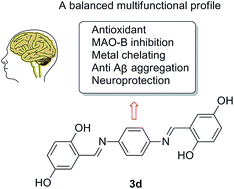Design of a structural framework with potential use to develop balanced multifunctional agents against Alzheimer's disease†
Abstract
A series of small molecules had been designed, synthesized, and evaluated as multifunctional ligands against Alzheimer's disease (AD). The results of biological activity tests showed that most of the molecules exhibited a significant ability to inhibit self-induced β-amyloid (Aβ1–42) aggregation, and to function as potential antioxidants and biometal chelators. Among these compounds, compound 3d was found to be highly potent and showed a balanced multifunctional profile covering inhibitory activity against self-induced Aβ1–42 aggregation (IC50 = 7.8 μM), strong free radical scavenging activities [IC50 (ABTS) = 1.82 μM; IC50 (DPPH) = 15.4 μM] and inhibitory activity against MAO-B (IC50 = 6.4 μM). Moreover, it showed excellent metal chelating properties and good inhibitory activity against Cu2+-induced Aβ1–42 aggregation, and was capable of decreasing reactive oxygen species (ROS) induced by Cu2+–Aβ1–42. Importantly, compound 3d was the most neuroprotective against neuronal death induced by oxidative stress and β-amyloid (Aβ1–42), and was able to cross the blood–brain barrier (BBB), according to a parallel artificial membrane permeation assay. These results indicated that compound 3d might be a promising lead compound for AD treatment.

- This article is part of the themed collection: Towards understanding and treating Alzheimer’s disease

 Please wait while we load your content...
Please wait while we load your content...